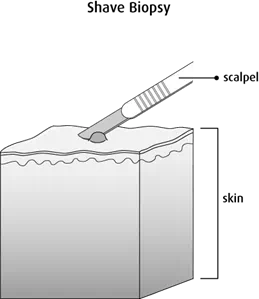Shave biopsy
A shave biopsy is a diagnostic test where a thin piece of skin is removed from the surface using a sharp blade. The skin is then examined under a microscope.
Why a shave biopsy is done
A shave biopsy is only used for growths or abnormal areas that are on the top or
outer layers of skin. This includes the
A shave biopsy is mainly done to diagnose:
- types of non-melanoma skin cancer such as basal cell carcinoma and squamous cell carcinoma
- other skin tumours including actinic keratosis (a precancerous condition of the skin)
- non-cancerous skin tumours or conditions such as seborrheic keratoses
In some cases, a shave biopsy is used as a treatment to completely remove a non-cancerous growth such as a wart or skin tag.
How a shave biopsy is done
A shave biopsy is usually done in the doctor’s office or in a clinic. It usually takes about 10–15 minutes.
The skin is cleaned and a local anesthetic is used to freeze the area so you won’t feel any pain. A round bump (called a wheal) may form. The doctor uses a sharp blade to shave off the tumour.
After the biopsy is done, a chemical is put on the wound or the wound is heated
with electricity to stop bleeding (called

Side effects
Side effects can happen with any type of test, but everyone’s experience is different. Most side effects of a shave biopsy are temporary. They may include:
- soreness or tenderness at the site
- a small amount of bleeding
- wound infection
- scarring
What the results mean
The biopsy sample is sent to a lab. A pathologist (a doctor who specializes in the causes and nature of disease) will examine the sample. The pathology report describes the types of cells found in the sample and if the cells are normal or abnormal.
An abnormal result may mean a non-cancerous growth, a precancerous condition or cancer.
Depending on the results, your doctor will decide if you need more tests, any treatment or follow-up care.
Your trusted source for accurate cancer information
With support from readers like you, we can continue to provide the highest quality cancer information for over 100 types of cancer.
We’re here to ensure easy access to accurate cancer information for you and the millions of people who visit this website every year. But we can’t do it alone.
Every donation helps fund reliable cancer information, compassionate support services and the most promising research. Please give today because every contribution counts. Thank you.
